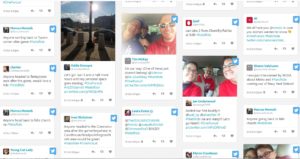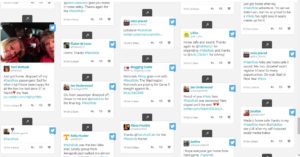I sold my tickets to a must-win baseball playoff game because the regional transit authority in the capital city of the United States refused to keep the trains running to get fans home.
The options, including leaving the game early or being stranded on the opposite side of town after midnight, weren’t good. As someone tweeted around the same time, “Anyone wanna go halfsies on a private jet? Skydive out onto South Capitol?”
While I decided to take a “not walking out early” stand, almost at exactly the same time a few bloggers hatched a plan to try to help a few people get rides home. They wrote a blog post, came up with a hashtag, and sent a single tweet:
@CALSGR8 @DaProc @Metrorailinfo We just wrote about this to be proactive with #NatsRide hashtag https://t.co/PzOytX9LiH
— TALK NATS Blog (@TalkNats2) October 12, 2016
And thus #NatsRide was born.
What happened next blew me — and them — away. Hundreds of tweets with the #NatsRide hashtag as people came together to offer rides and help match up people who needed a ride with someone going their way.
It takes a community to get a ride home.

I talked to Steve Mears of TalkNats about #NatsRide and the reaction that ensued. I asked him first about the genesis of the idea and what he had hoped to accomplish.
“We saw a crisis at hand and a lot of inaction with finger pointing with Metro on one side and fans on the other and you could see that Metro was dug in and was not going to change.
“We had a writers meeting on what we could do given that our TalkNats blog has thousands of readers — and, on top of that, our Twitter, Facebook, and Instagram social media reach is thousands more. If we could spread the word, thousands could reach thousands more. We came up with #NatsRide hashtag as a catchy idea to be proactive and not beg people to stay [until the game ended] but rather find a creative “ride” solution to their transportation issues. It was asking a lot for the 15,000 to 18,000 estimated riders who relied on Metro but we saw no way Metro was going to change and stay open.
“We wrote the blog post overnight and planned on publishing it near 7 am when it would have better impact but we kept making revisions and got it posted at 8:13 am. The first #NatsRide tweet we put out 2 minutes afterwards at 8:15 am. That original blog post tweet was retweeted 5 times. From there it went viral in hours and was trending on Twitter.”
Were you surprised by how much it took off?

“I was shocked! I am not a social media expert but had faith in the Nats fans and people who follow our site that if we could help a few dozen that was good and our goal was modest. I helped over 150 just by early afternoon as I was tying people together. People really seemed to like it. We then called in help from [Nationals pitching ace] Max Scherzer’s wife Erica and others who had influence. Soon we had media calls from 2 writers at the Washington Post, both of whom interviewed me and did articles which reached thousands more. Then the local TV news stations were inquiring. Then we had TV networks as far as Hagerstown, MD, covering #NatsRide, and finally [Washington, DC] Mayor Bowser herself tweeted about it. It was exponential the millions that were reached as it spread over the entire region and beyond. It was trending on Twitter for 2 days!
“We were happy to promote businesses who were helping, like Parking Panda, Potomac Riverboats, Ballpark Bus, Bikeshare, Uber and Lyft, and others. It was a win-win and these businesses will prosper into the future by this. I didn’t know myself about the boating option but we asked on our TalkNats blog if people had suggestions and we did updates throughout the day as options and ideas came around. We watched like everyone else for the Metro message to go on the big screen [during the game] and there was no mass exodus. It was amazing. So few left it was like a trickle to the Metro. It’s easier to leave when you see others doing it but people stayed in their seats and stayed till the end. It was a huge success!”
As #NatsRide showed, hashtags can be powerful tools.
@TalkNats2 You owned the night last night. Never seen anything like it. The #Nats lost but fans are celebrating #NatsRide like a victory.
— PowerBoater69 (@PowerBoater69) October 15, 2016
Hashtags were created simply to track a conversation across one or more social platforms. Gradually their usage has widened from the trite (e.g., hashtag stuffing) to events (e.g., #Postseason, #fifaWWC, #Greenbuild16, #Oscars) to movements and demonstrations of solidarity (e.g., #BlackLivesMatter, #ImWithHer).
#JeSuisParis was the #1 hashtag on Twitter in 2015.
In the case of #NatsRide, the reaction was organic. Because of my connection to a core group of baseball fans on Twitter, I wasn’t surprised that people reached out to me to see if I needed fresh tickets or had secured a ride home. (Which fits in with what Mears had initially hoped to accomplish). But I was amazed by the regional reach and scope of the reaction — and how many people stepped up to ask for rides, offer rides, and connect people. Indeed, #NatsRide brought a community together to proactively solve a problem that neither the team’s billionaire owners nor the city was doing anything to address.
It’s also a reminder that social media — and hashtags — can sometimes be awesome.



